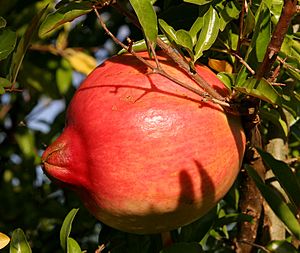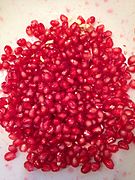Punica facts for kids
Quick facts for kids Punica |
|
|---|---|
 |
|
| Punica granatum | |
| Scientific classification |
|
| Kingdom: | Plantae |
| Clade: | Tracheophytes |
| Clade: | Angiosperms |
| Clade: | Eudicots |
| Clade: | Rosids |
| Order: | Myrtales |
| Family: | Lythraceae |
| Subfamily: | Punicoideae (Horan.) Graham, Thorne & Reveal |
| Genus: | Punica L. |
| Species | |
|
See text |
|
| Synonyms | |
|
Socotria G.M.Levin |
|
Punica is a small group of plants that grow fruits. They are usually deciduous shrubs or small trees, meaning they lose their leaves every year. These plants belong to the Lythraceae family.
What's in a Name?
The name of the genus Punica was first given by a famous scientist named Carl Linnaeus in 1753. He wrote about it in his book Species Plantarum. The most well-known plant in this group is the pomegranate, also known as Punica granatum.
The word Punica comes from an old Latin name for the pomegranate, which was malum punicum. This means "Carthaginian apple" or "apple from Carthage".
What Do Punica Plants Look Like?
Plants in the Punica group are usually shrubs or small trees. They can grow to be about 6 to 10 meters (20 to 33 feet) tall. Their leaves grow in pairs on opposite sides of the stem.
The flowers and fruits of these plants can be yellow or bright red. The fruits are a type of berry with a tough, leathery skin. Inside, the fruits have many seeds. Each seed has a soft, edible covering, which is the part we eat.
Types of Punica Plants
There are only two main types of plants officially recognized in the Punica genus:
- Punica granatum: This is the common pomegranate. It first grew in the area that is now Iran. People have been growing it for a very long time around the Mediterranean region and in northern India.
- Punica protopunica: This plant is called the Socotra pomegranate. It only grows on the island of Socotra. It is different from the common pomegranate because its flowers are pink, not red. Also, its fruits are smaller and not as sweet.
Scientists used to think Punica belonged to its own plant family called Punicaceae. However, newer studies that look at how plants are related (called phylogenetic studies) have shown that Punica actually belongs to the Lythraceae family. This is where it is classified today.
See also
 In Spanish: Punica para niños
In Spanish: Punica para niños





